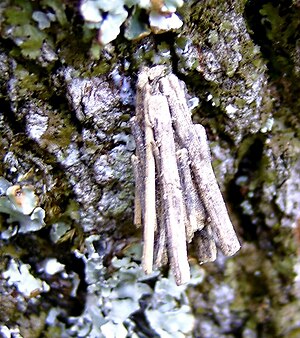Big smoke bag carrier
| Big smoke bag carrier | ||||||||||||
|---|---|---|---|---|---|---|---|---|---|---|---|---|

Caterpillar sacs of the Great Rauch- Sackbearer ( Psyche crassiorella ) |
||||||||||||
| Systematics | ||||||||||||
|
||||||||||||
| Scientific name | ||||||||||||
| Psyche crassiorella | ||||||||||||
| ( Bruand , 1851) |
The large smoke sack carrier ( Psyche crassiorella ), also known as the shimmering brown sack carrier , is a butterfly from the family of the real sack carrier (Psychidae).
features
butterfly
The adult animals are characterized by a clear sexual dimorphism . The wings of the males reach a wingspan of about 14 to 16 millimeters and are glossy gray or gray-brown in color. Their antennae have more than 21 links. The maggot-like females have a light brown basic color with some dark horizontal stripes and have a cylindrical body. They have neither developed antennae nor wings and their legs are stunted.
Caterpillar, pupa
The caterpillars have a bright yellow head. They spin themselves into a sack-like living tube in which they also pupate. On the outside, the caterpillar attaches large parts of plant stems of about the same diameter, which often protrude far. The length of the caterpillar sac is about 11 to 15 millimeters.
Similar species
The species is similar to the Kleiner Rauch-Sackträger ( Psyche casta ). However, their male moths are smaller and more brownish in color. Their antennae have fewer than 21 links. With a length between 6 and 9 millimeters, the bags are also significantly smaller and covered with thinner plant parts.
Distribution and occurrence
The Big Rauch-Sackträger comes from the coasts of the Mediterranean countries through climatically temperate Europe, including England and north to central Fennoscandinavia . In the Alps it can still be found at heights of 1200 meters. It mainly inhabits dry grasslands and rocky slopes.
Way of life
The moths fly in one generation from May to July. The animals have a two-year development cycle. The caterpillar remains in its protective cover during the entire caterpillar stage. Only the male adult butterfly leaves the caterpillar sac and seeks out the flightless female to mate. Both sexes have a lifespan of just a few days, ending shortly after mating. The caterpillars feed on various grasses, mosses, green algae ( Chlorophyta ) and lichens , as well as the blood-red cranesbill ( Geranium sanguineum ). The larval sac is attached to tree trunks and rocks, sometimes several meters above the ground.
Danger
The species is widespread in Germany and can usually be found in large numbers, so that it is not considered endangered.
swell
Individual evidence
- ↑ Walter Forster, Theodor A. Wohlfahrt: The butterflies of Central Europe. Volume 3: Weirdos and Swarmers. (Bombyces and Sphinges). Franckh'sche Verlagshandlung, Stuttgart 1960, DNB 456642196 .
- ↑ a b Günter Ebert, Thomas Esche, Rene Herrmann, Axel Hofmann, Hans Georg Lussi, Ingo Nikusch, Wolfgang Speidel, Axel Steiner, Jürgen Thiele: The Butterflies of Baden-Württemberg Volume 3, Moth I (Root Borer (Hepialidae), Wood Borer (Cossidae ), Ram (Zygaenidae), snail moth (Limacodidae), sack carrier (Psychidae), window spot (Thyrididae)), Ulmer Verlag Stuttgart 1993, ISBN 3-800-13472-1
- ↑ Josef Wolfsberger: New and interesting Macrolepidoptera finds from southern Bavaria and the adjacent northern Limestone Alps , communications from the Munich Entomological Society 40, 1950
- ↑ Wolfgang Dierl: Cytology, morphology and anatomy of the sack moth Fumea casta (Pallas) and crassiorella (Bruand) as well as Bruandia comitella (Bruand) (Lepidoptera, Psychidae) with crossing experiments to clarify the species specificity. , Zoological Yearbooks, Systematics, 91, 1964
literature
- Günter Ebert, Thomas Esche, Rene Herrmann, Axel Hofmann, Hans Georg Lussi, Ingo Nikusch, Wolfgang Speidel, Axel Steiner, Jürgen Thiele: The Butterflies of Baden-Württemberg, Volume 3, Moths I (root borer (Hepialidae), wood borer (Cossidae), ram (Zygaenidae), snail moth (Limacodidae), sack bearer (Psychidae), window stain (Thyrididae)), Ulmer Verlag Stuttgart 1993, ISBN 3-800-13472-1
- Walter Forster , Theodor A. Wohlfahrt : The butterflies of Central Europe. Volume 3: Weirdos and Swarmers. (Bombyces and Sphinges). Franckh'sche Verlagshandlung, Stuttgart 1960, DNB 456642196 .
Web links
- www.lepiforum.de Photos
- www.schmetterlinge-deutschlands.de Endangerment
- Psyche crassiorella in Fauna Europaea